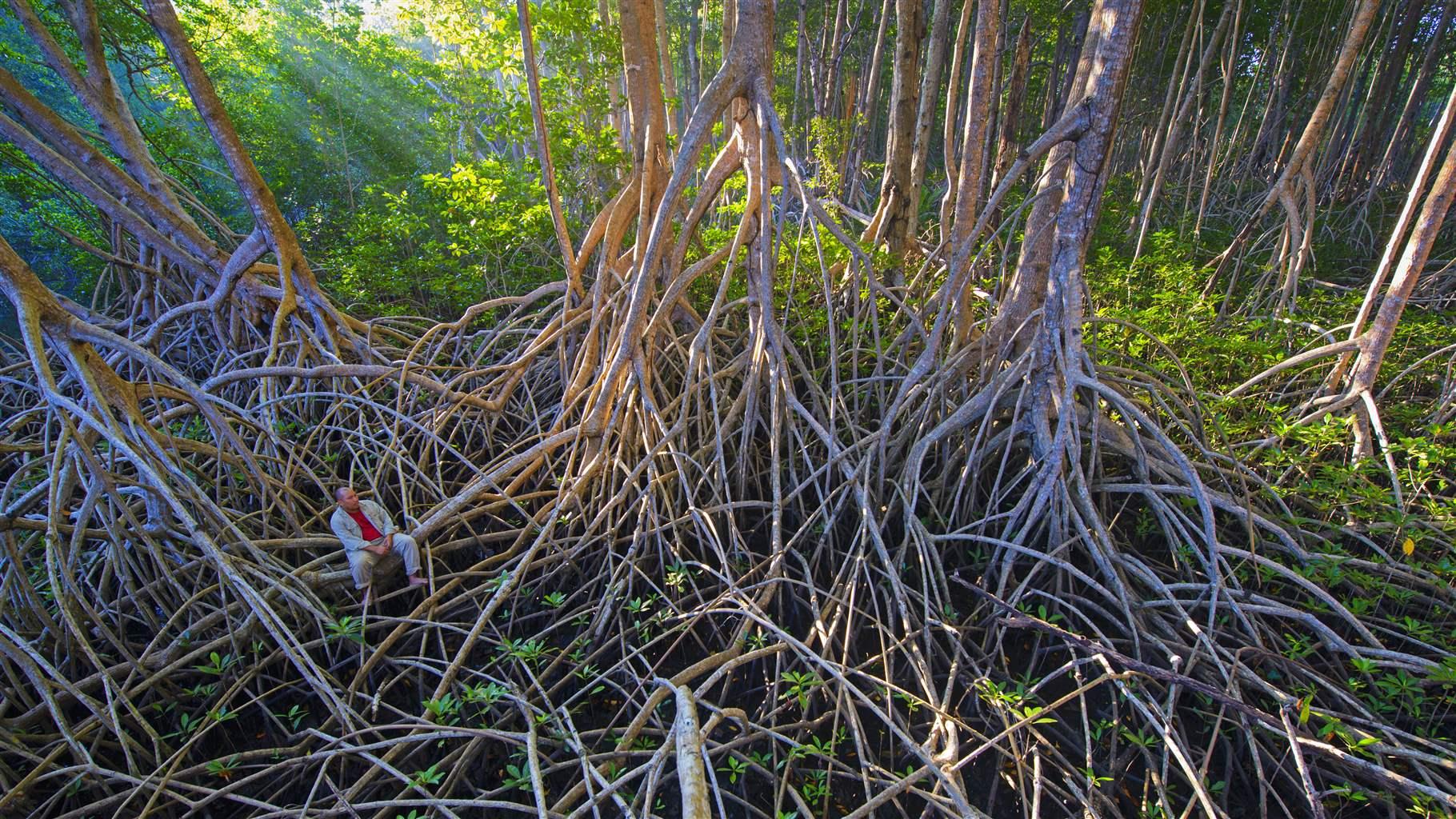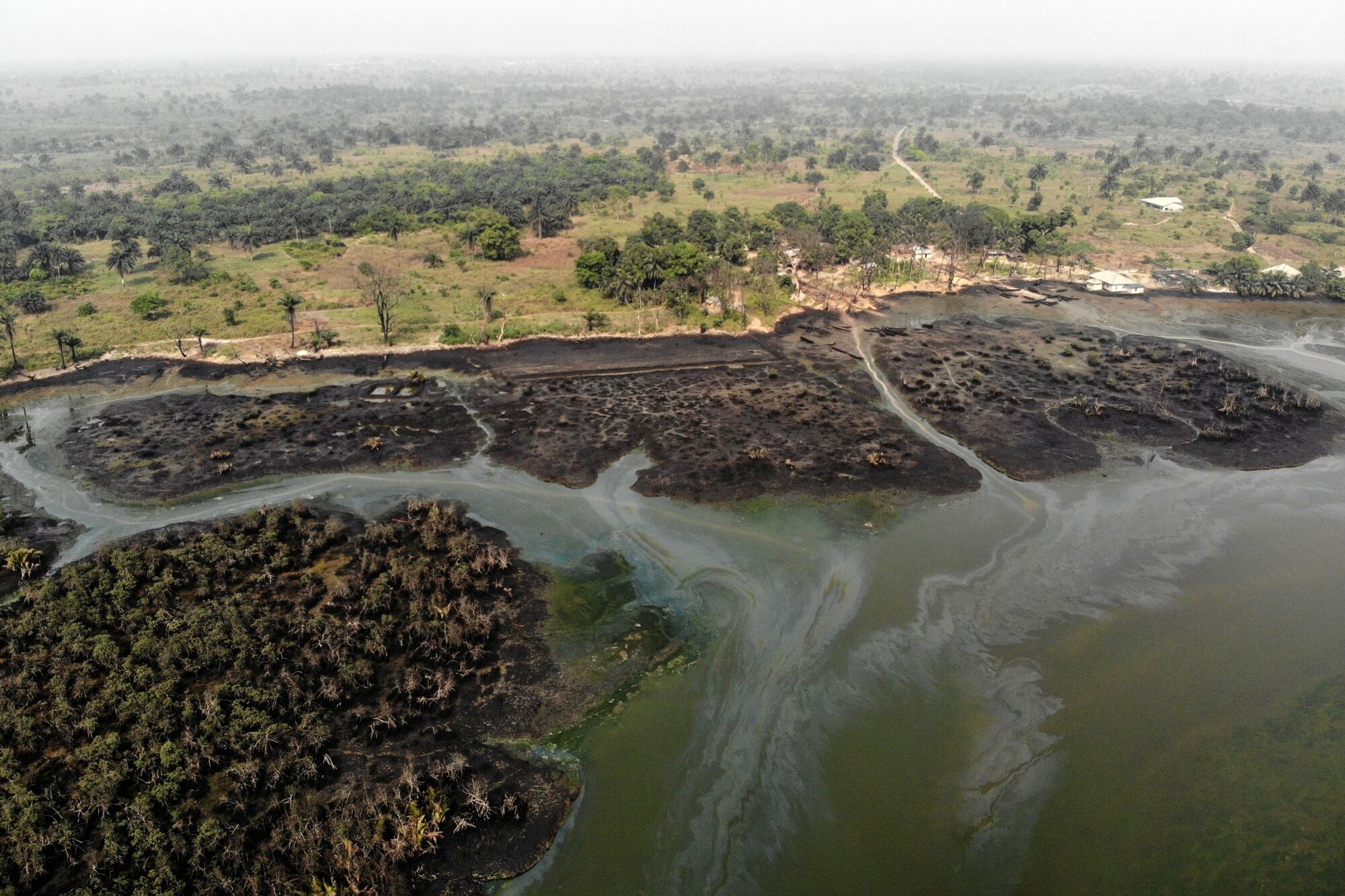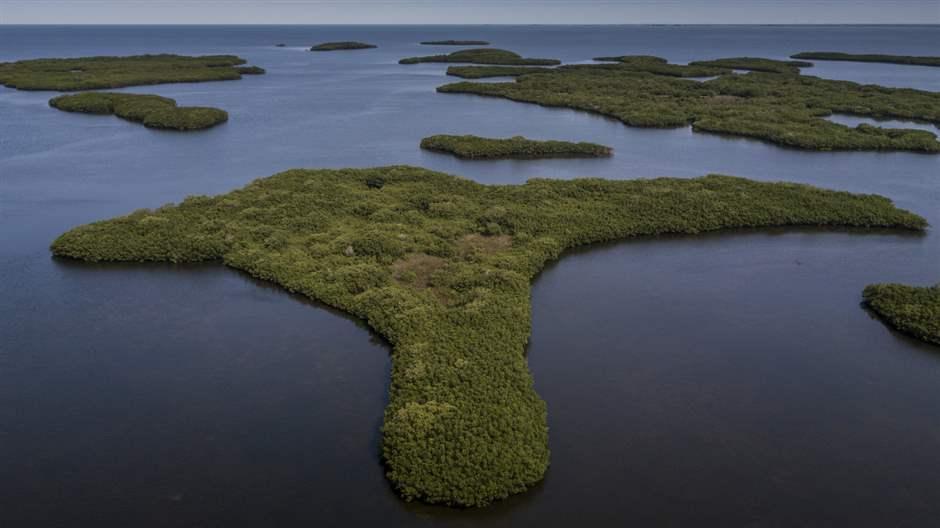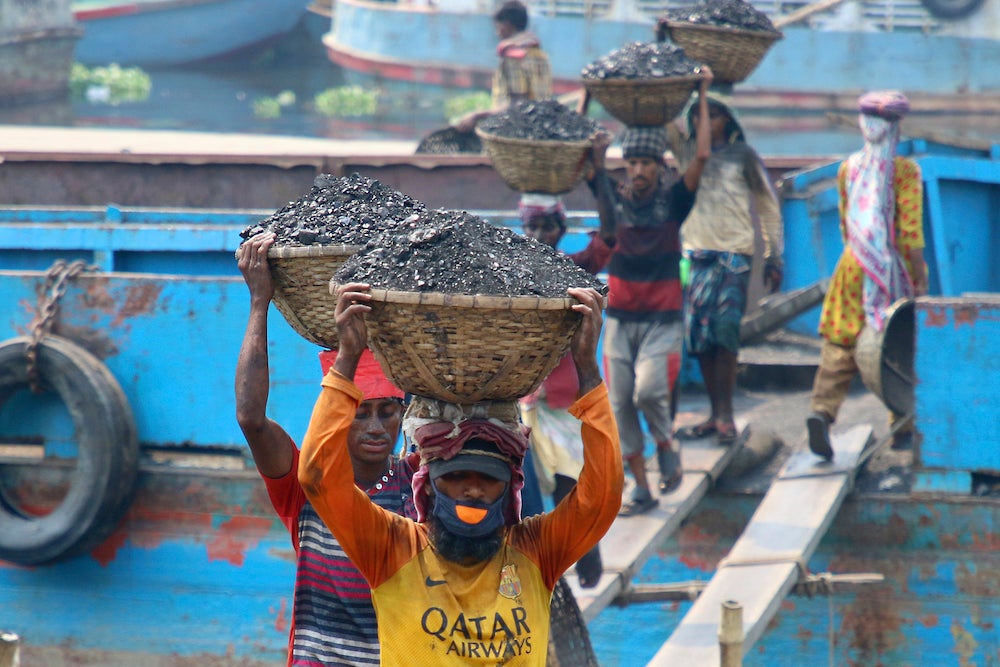FEATURE Mangrove Conservation Can Help Countries Meet Emissions Reduction Goals

MEXICO – Protecting mangrove forests—one of the planet’s most effective habitats for capturing and storing atmospheric carbon dioxide—could help countries meet their goals for reducing carbon emissions while providing other ecosystem benefits, according to new research. A team of researchers, including 2018 Pew marine fellow Octavio Aburto-Oropeza, used Mexico as a case study to demonstrate how countries can use the carbon storage potential of their mangrove forests to estimate the climate-related costs of deforestation. This type of accounting, the team says in its article published in the peer-reviewed journal Ambio, can enable countries to make progress toward emissions reduction targets by conserving their coastal habitats. The research was led by Joy Kumagai at the Scripps Institution of Oceanography at the University of California, San Diego, where Aburto-Oropeza is an associate professor of marine biology. Aburto-Oropeza hopes that the research will inform future decision-making about how and where conservation resources are applied to maximize environmental and societal benefits, which extend well beyond carbon sequestration. As the authors wrote in their article, “If the costs of these programs are less than the projected damages, the benefits far outweigh the investment, as mangroves provide numerous other valuable ecosystem services.” READ MORE GLOBAL Thresholds of mangrove survival under rapid sea level rise

GLOBAL – The rate of sea level rise has doubled from 1.8 millimeters per year over the 20th century to ∼3.4 millimeters per year in recent years. Saintilan et al. investigated the likely effects of this increasing rate of rise on coastal mangrove forest, a tropical ecosystem of key importance for coastal protection (see the Perspective by Lovelock). They reviewed data on mangrove accretion 10,000 to 7000 years before present, when the rate of sea level rise was even higher than today as a result of glacial ice melt. Their analysis suggests an upper threshold of 7 millimeters per year as the maximum rate of sea level rise associated with mangrove vertical development, beyond which the ecosystem fails to keep up with the change. Under projected rates of sea level rise, they predict that a deficit between accretion and sea level rise is likely to commence in the next 30 years. READ MORE Threatened mangrove forests won’t protect coasts

GLOBAL – If sea levels go on rising at ever higher rates, then by 2 Researchers from Australia, China, Singapore and the US report in the journal Science that they looked at the evidence locked in the sediments in 78 locations from the last 10,000 years, to work out how mangrove forests have – through the millennia – responded to changes in sea level. At the close of the last ice age, sea levels rose at 10mm a year and slowed to nearly stable conditions 4000 years ago. In a high emissions scenario, by 2050 sea level rise would exceed 6mm: the scientists found a 90 per cent probability that mangroves would not be able to grow fast enough to keep up. Nor – because of the development of coastal settlements worldwide – would the forests be able to shift inland. “This research therefore highlights yet another compelling reason why countries must take urgent action to reduce carbon emissions,” said Benjamin Horton of Nanyang Technical University in Singapore, one of the researchers. READ MORE Forests in a time of crises

GLOBAL – People everywhere recognize that forests and trees help combat climate change, biodiversity loss and land degradation. Many also understand their importance to rural livelihoods. Getting trees in the ground, keeping them there, and ensuring that the potential benefits materialize are not easy. In 2019, two of the world’s leading organizations focused on forestry and agroforestry, the Center for International Forestry Research (CIFOR) and World Agroforestry (ICRAF) embarked on a bold merger venture in order to provide the evidence and innovative solutions needed to scale up investment in sustainable development and address the global challenges of our time. Uniquely equipped to deliver transformative science thanks to the diverse skills of our more than 700 staff and long-established partnerships, CIFOR-ICRAF is better placed than ever before to address local challenges and opportunities while solving global problems. READ MORE AFRICA Fish prices spike as Cameroon’s mangroves face total depletion

CAMEROON – In Cameroon, extensive mangrove systems provide an abundance to the communities that surround them. From firewood to fish, communities have depended on mangroves, locally known as matanda, for years. These low-lying, tide-resistant shrubs grow in salty water and cover nearly 60 percent of the southwest region alone, but also spread across three regions: Rio de Ray, Wouri Estuary Douala and Ntem South, according to Ekwadi Songe, southwest regional delegate of environment, nature protection and sustainable development. Due to overfishing and overharvesting its wood, mangroves have seriously depleted in recent years. Sea level rise due to climate change also threatens the mangrove ecosystem. Now, during the COVID-19 pandemic, a spike in the price of fish is largely blamed on mangrove depletion. As of 2010, Cameroon’s mangroves were nearly 75 percent depleted, but today’s figures are likely much higher, according to the Andalou Agency. “If mangroves go extinct, fish will finish in Cameroon,” said Songe, the southwest regional delegate. READ MORE The Toxic Legacy of 60 Years of Abundant Oil

NIGERIA – It’s one of the most polluted spots on Earth, and prospects of a turnaround only get worse as Covid-19 guts a global industry. In the past decade, crude has gone from providing about 80% of all Nigerian state revenue to about 50% last year. This year, with the global economy hit by the coronavirus adding to existing trends as the world shifts away from fossil fuels, the government projects an 80% decline in oil income. That creates a bitter reality for residents at the center of Africa’s biggest petroleum industry: they’ll have little help cleaning up pollution that’s deprived entire communities in the Niger River delta of their fishing and farming livelihoods. “Over so many years both the government and the oil companies have made promises to clean up without doing so,” said Pius Waritimi, an art teacher and environmental activist based in the southern oil hub of Port Harcourt. “If oil loses its importance as a source of revenue, it’s likely the Niger delta will be abandoned to its fate.” READ MORE AMERICA New Aquatic Preserve Off Florida Is Big Win for Wildlife, Habitat, and Long-Term Economy

USA – Off Florida’s west coast, seagrass beds stretch for miles and for decades have supported a significant part of the regional economy. That’s why the Florida House and Senate passed legislation to protect about 400,000 acres of seagrass—a measure that Governor Ron DeSantis (R) signed into law today. The Nature Coast Aquatic Preserve off Citrus, Hernando, and Pasco counties is the first new preserve to be designated in more than 30 years and the 42nd in a state system designed to maintain water quality and biological value to ensure healthy ecosystems. The preserve, which covers part of the Gulf of Mexico’s largest seagrass bed, still allows traditional activities such as boating, fishing, and scalloping. “The Nature Coast Aquatic Preserve is an essential tool in keeping our marine environment healthy,” said Mike Desabrais, vice president of Port Hudson Fishing Club in Pasco County. “Lawmakers and the governor have significantly helped that environment, and future generations will see great value in their efforts.” READ MORE ASIA Unknown phenomenon destroying northern wetlands

MALDIVES – “People used to say back then that even a bullet could not pass through the mangroves. That the mangroves were so thick, that even a bullet could not pass through. As long as I can remember, there were a lot of small-leafed orange mangroves.” Ali Adam, ,H.Dh. Neykurendhoo Council president reminisced his childhood. The wetland of Neykurendhoo, is some of the biggest in the country. The most prominent mangrove in the area is the small-leafed orange mangrove, locally called kan’doo. Residents of Neykurendhoo grew up by sourcing food from these trees. The strong wood from the small-leafed orange mangroves was used to build boats. The area is nature’s gift for the island and remains as its pride. However, this is slowly becoming the past. Ali Adam said that the mangroves were not as thick and strong as they used to be. Dangers faced by the mangroves have led to questions surrounding its future. Tree leaves in a large portion of the area have turned yellow. The trees on the other hand are withering and dying. Neykurendhoo is not the only location to be hit by this phenomenon. The wetlands of H.A. Kelaa and N. Kendhihulhudhoo are also experiencing similar issues. READ MORE Bangladesh coal plants threaten world’s largest mangrove forest

BANGLADESH – Cyclone Amphan, the most powerful to strike in the Bay of Bengal in 20 years, made landfall on the India-Bangladesh coast last month. Amphan ripped off roofs, washed away homes, and flooded farms. Crucially, Bangladesh was able to mitigate impact and save lives because of its robust emergency response system with early warnings and mass-evacuations. But coastal communities were also protected by Bangladesh’s natural storm shield: the Sundarbans. A protected World Heritage site, this mangrove forest holds land together with its roots as the tides rise. As climate change increases the intensity of extreme weather events like Amphan, the Sundarbans are at risk when they’re needed most. But the Bangladesh government threatens to destroy these life-saving forests by building coal-fired power plants that could subject them, and the nearly 2.5 million people who depend on them for their livelihoods, to harmful pollution. And while the mangroves slow climate change by soaking up carbon, coal-fired plants contribute greenhouse gas emissions that fuel global warming. READ MORE Plant 50 million mangroves in the Sundarbans? Improbable, say experts

BANGLADESH – The Sundarbans would need an area nearly half the size of Kolkata to plant 50 million mangrove trees as decided by the West Bengal government recently, which is improbable, experts have said. They cited a lack of space as the primary reason along with a number of other factors. On World Environment Day (June 5, 2020) this year, Bengal Chief Minister Mamata Banerjee announced that 50 million mangroves would be planted in the Sundarbans in the near future. The reason was to compensate for the plants’ loss during the recent Cyclone Amphan, that made landfall near Sagar island in the Sundarbans. A healthy mangrove population in the Sundarbans is considered critically important as it works as a barrier to high-intensity cyclones that impact the islands of the delta as well as its hinterland including Kolkata. Banerjee said about 28 per cent of the Sundarbans had been damaged by the cyclone and pointed out 1,200 square kilometres of the 4,260 sq km forest had been ‘destroyed’ severely, affecting its mangrove population. The Indian Sundarbans are spread over 9,630 sq km, of which, nearly 5,400 sq km is inhabited by humans while the rest is forest area. “The figures are not matching up. It is a fact that about 4,260 sq km in the Sundarbans is forest area. But close to 50 per cent of that is water,” an expert on the Sundarbans, said on the condition of anonymity. READ MORE The Malay Peninsula is a dispersal barrier to certain mangrove species

MALAYSIA – US ecologists showed that mangrove tree species with seeds/seedlings that float and survive shorter periods at sea have limited ability to disperse across the Malay Peninsula.Southeast Asia, with its thousands of islands and complex geological history, is one of the most interesting regions in the world to test ideas about dispersal by sea. The distribution and genetic patterns of coastal organisms that we see today contain signatures of their past dispersal activities and allow us to examine how genes moved across this complex landscape impact dispersal activities at present. A research team led by Prof Edward WEBB and comprising his then Ph.D. student, Dr Alison WEE from the Department of Biological Sciences, NUS used molecular tools to examine the genetic relationship among populations of four commonly occurring mangrove species in Southeast Asia. They showed that the Malay Peninsula functions as a filter to genetic exchanges between the South China Sea and the Malacca Strait. READ MORE OCEANA Mangrove collapse ‘inevitable’ unless emissions curbed

AUSTRALIA – The threshold beyond which the world’s mangrove forests can survive could be reached within the next 30 years if sea levels continue to rise at their current pace and greenhouse gas emissions are not curbed, according to new research. Mangroves have two particularly important roles: they buffer vulnerable coastlines from severe weather systems such as cyclones and storm surges, and are considered to be some of the most valuable carbon sinks of any terrestrial forests. Researchers studied samples of sediment from 78 tropical or subtropical mangroves that built up between 10,000 and 7,000 years ago, part of what are known as the final stages of the Holocene period, when glaciers were melting and sea levels rose as a result. They determined that mangroves can only withstand a maximum relative rise in sea levels of 7 millimeters, about a quarter of an inch, per year: “a limit beyond which mangrove systems cease to function,” according to a statement that accompanied the report. Mangroves are able to adapt to fluctuations in sea level, but they have their limits, said one of the report’s co-authors, Neil Saintilan, a professor in the Department of Earth and Environmental Sciences at Macquarie University in Sydney, Australia. READ MORE LAST WORD Dear All, Please help spread the word on this year’s children’s mangrove art calendar competition! The contest is now open to anyone from any country between the ages of 6-15. Keep in mind, the deadline is Aug. 30th, so lets get those entries in ASAP! Do you know a budding artist or a gifted child? We would love to feature their vision of what the mangroves mean to them, our planet and their future. For more information, please visit Mangrove Action Project Calendar Project or download the PDF here Ciao,
Monica Quarto
Like this newsletter?
Pease consider donating to MAP to keep it going.
Giving could never be easier | INTERVIEW – Yale Climate Connection interview with MAP’s Alfredo Quarto LISTEN CHILDREN’S ART CALENDAR  ACTION ALERTS Unilever: stop destroying mangroves for convenience food! SIGN OUR PETITION Stop plundering the oceans for industrial aquaculture! SIGN THE PETITION Take action now and stop the build-out of coal plants in Bangladesh. Save Kakinada mangrove forest – Sign the Petition Enough! Pledging zero tolerance to attacks against environmental and human rights defenders. SIGN THE PETITION Like this newsletter? Pease consider donating to MAP to keep it going. Giving could never be easier 
CBEMR Training in Tanzania: Ground-breaking training breathes life into mangrove ecosystem restoration – The Mangrove Alliance Please see our newest video: ” Restoring The Natural Mangrove Forest” – https://youtu.be/Vh7CoPBLQa8 Mangrove Restoration Map VIEW MAP HERE 
Restoring The Natural Mangrove Forest
Watch movie 
Community Based Ecological Mangrove Restoration in Rufiji Delta VIEW VIDEO Video: Mangroves for the Future – A look bacK. As the latest phase of Mangroves for the Future (MFF) draws to a close, this video highlights some of the project’s most successful initiatives – from local women supporting national park management in Viet Nam to an island in the Maldives that has become a model for waste management, and everything in between. View Here WANT TO GET INVOLVED?
Follow and Join MAP!    
Like this newsletter? Pease consider donating to MAP to keep it going. Giving could never be easier 

VOLUNTEER OPPORTUNITY 
MANGROVE ISSUES Want to learn more about mangroves?
Our short presentation will give you a better understanding of the issues we are working to solve. WATCH PRESENTATION What is CBEMR? Download MAP’s 2 page CBEMR Information Sheet containing links to all MAP’s CBEMR resources – CLICK HERE What is EPIC? – The Ecosystems Protecting Infrastructure and Communities (EPIC) project: the role of ecosystems as protective barriers against climate induced hazards MANGROVES APP AVAILABLE
A pictorial field guide for easy identification of various mangrove species and learning about the mangroves ecosystem. CLICK HERE View MAP’s uploaded Videos at MAPmangrover’sChannel
Question Your Shrimp Consumer/Markets Campaign!
WATCH VIDEO WATCH – Mangroves: how they help the ocean
 Mangrove Restoration in Asia – Watch Short Video The Value of Mangrove Forests View Video CBEMR Experience Exchange MAP 2017 English Subtitles
VIEW THE VIDEO Mangroves: Guidebook to Malaysia – Click Here
Mangrove rehabilitation in Asia – Local Action and cross-border Transfer of Knowledge for the Conservation of Climate, Forests and Biodiversity VIEW VIDEOS HERE SHARE MAP’S VISION
CLICK HERE to watch short introductory video. Together we can work “at the roots of the sea”. Our short documentary, Reducing the Risk of Disaster through Nature-Based Solutions : Mangroves

Exclusive Interview with Alfredo Quarto, Co-Founder and Executive Director of Mangrove Action Project – See more
Marvellous Mangroves Curriculum The Marvellous Mangroves Education Forum is an online hub for those utilizing the Marvellous Mangroves (MM) Curriculum. It gives students, teachers and anyone interested in mangroves, the opportunity to learn and share ideas themed around the curriculum, to connect and communicate with others around the globe whilst exploring mangroves from your computer or on the go. VISIT 
The award-winning Marvellous Mangroves (MM) curriculum educates children on the importance of mangroves and their ecological functions, teaching them about modern challenges and mechanisms for sustainability. VIEW VIDEO Marvellous Mangroves Curriculum in Bangladesh – WATCH VIDEO
MARVELLOUS MANGROVES IN BRAZIL
En Portuges 
Marvellous Mangroves – A Curriculum-Based Teachers Guide. FOR MORE ON MAPs AWARD WINNING CHINA MANGROVE CURRICULUM VISIT

VIMEO SHOW
VISIT OUR “MM” WEBPAGE Check out our presentation for more details on Marvellous Mangroves Read this 10 page history of the development of MAP’s educational curriculum VIEW DOCUMENT
Article in Canada’s Green Teacher Magazine – Read More
Like this newsletter? Pease consider donating to MAP to keep it going. Giving could never be easier 
Green Planet Fundraising Assists MAP – LEARN MORE
Volunteer Opportunities with Mangrove Action Project CLICK HERE
“Question Your Shrimp” Campaign Question Your Shrimp- Don’t Buy or Sell Imported Tropical Shrimp! Sign the Petition Learn more about the affects of the shrimp industry on mangroves by visiting our blog
Editor’s Note: Mangrove Action Project’s Executive Director, Alfredo Quarto was interviewed about shrimp by Green Acre Radio’s Martha Baskin
LISTEN TO INTERVIEW Sign the Consumer’s Pledge to avoid imported shrimp
Not yet a MAP News subscriber?
Click here to subscribe. Note to Our Readers: We strive to keep active links in our newsletter. However, due to circumstances beyond our control, occasionally links to stories may become broken. If you find a link to a story is not functioning, please cut and paste the headline into your browser search bar. In most cases you should be able to locate the original story.
|




























